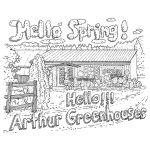A brief introduction
In this post we give you step by step guidelines for tree and shrub planting as your garden cannot do without trees or shrubs. They give structure to a garden and can also save energy, provide shade on your sitting area and so on.
We realize that purchasing these items can be pricey. That is why we give directions and tips to give your trees and shrubs an optimal start. And that actually starts before planting, which we will discuss step by step further below.
Tree and shrub planting
Plant a tree or shrub that will grow well given, your hardiness zone, existing soil conditions (sandy, loam or clay), sun exposure and available moisture (wet or dry spots). Don’t forget it will grow to its mature size and still has to match the spot, without branches rubbing your walls, gutter or roof or intertwining with other trees and shrubs or hydro lines!
Species that are native to the area are most likely well adapted to the climate in your part of the country. If you’re planting a non-native species, research its site requirements carefully.
We recommend involving Ontario One Call before starting any project that requires digging, even small projects like planting shrubs. Hitting an underground utility line with your shovel can knock out power to your house or neighborhood, and it can cause serious bodily harm -even death- not to mention a rather large bill from the utility company.
Dig a fresh hole. If you’re planting in clay or wet soil, use a garden fork or your spade to roughen the bottom and sides of the planting hole to avoid glazing. Glazing happens when the sides and bottom of a hole become so smooth and compacted that water can’t pass easily through the soil. In extreme situations, it could block roots from penetrating the sides of the planting hole.
A good rule of thumb is to dig a hole that’s twice the width of the container and just as deep or a little deeper. For a tree a wheelbarrow is most likely to small to hold al the soil. Use a tarp to deposit your soil on and keep topsoil separate from other soil layers. Loosen the soil at the bottom of the hole and on the sides. Loosening the soil makes it easier for the roots to embed themselves into the ground.
If your tree or shrub requiers drier conditions we recommend to dig the hole deeper and put some stones on the bottom. This also applies to gardens with little topsoil (new subdivisions!) and clay in underlying soil layers. The water can drain away from the roots after a heavy rainfall or in case of overwatering.
It never hurts to spread bone meal or blood and bone meal on the bottom and the sides of the plant hole. You can’t overdo; it is slow working.
At this point we are not in favor to wet the entire hole. Maybe you have to dig a bit more to fit the tree or shrub in the hole which is easier with dry soil.
Remove the tree or shrub from the container. The easiest way to do this is to roll the container with slight pressure on the sides and slide the shrub or tree out. If this doesn’t work cut the container on both sides with a utility knife. Before putting the tree in the hole, rake your fingers across the side of the root ball to loosen it. This breaks the roots from their circular growth pattern and helps ensure strong, healthy root system development.
If the tree is severely root-bound, cut the root-ball using a pruning knife and try to spread them out or remove them.
Never pick up the tree by its trunk. Instead, support the tree from under or from the side of the root-ball.
Now, slide the tree into the hole and center it in the hole. A graft should always be just above the ground. Notice that if you plan to use mulch the graft should never be covered with mulch as well, unless you use a collar to keep the mulch away from the graft.
For an a tree or shrub without a graft the root or trunk flare -where the roots begin to spread out and the trunk begins to get thicker- should be just below the surface.
Once the tree is in the hole, take a step back and confirm that it looks level and isn’t leaning to either side. If your tree doesn’t stay upright or if you live in an area that gets high winds, we recommend to use at least two stakes to help it stand up straight. Make sure the lines don’t cut into the tree. Wide, smooth fabric straps are a good choice. If you use cord or wire, cushion the trunk; segments cut from a garden hose you’re no longer using around he wire work well for this.
Backfill the hole with the soil you removed. Use the soil from the sub-layers (if any) first. You can mix the soil with a bit of peat moss, triple mix, black earth or topsoil to improve the soil quality in case of heavy clay or poor soil. As you’re backfilling, lightly pack the soil. This will help eliminate air pockets. When the hole is about halfway full, give the ground a healthy dose of water and let it drain away before you start backfilling again. This will also eliminate air pockets and provides needed moisture to the roots. Add the topsoil from the original level of topsoil in your garden.
Trees will typically do better in native soil than amended soil. In most cases, roots that are planted in amended soil rarely spread outside that area and end up circling around the amended area instead.
Adding a layer of mulch will help hold the moisture in and keep the roots nice and cool for a healthy tree. Add at least 2 inches at the base of the tree for good coverage. Use 4 inches of mulch if you want to keep weeds away. Once you’ve got it down, pull it back from the trunk of the tree a few inches so it doesn’t contact the trunk.
Make sure the tree stays watered well until it’s fully established. Some trees can take up to a year to become properly established. To keep your tree watered, you can water by hand, or use an (automated) drip irrigation system. Is your tree out of reach for your garden hose? Put water in a wheelbarrow and carefully pour it around your tree.
Last but not least...
Remove any tags and labels from the tree as these will affect the tree as it grows.
A tree guard -a plastic tube or plastic spiral wrapped around the tree’s trunk- will protect young trees from rabbits and mice in winter. They especially like young fruit trees and burning bushes. If snow is piling up in the winter, make sure you ad extra tree guards or pull them up.
Most trees do not need to be staked. If your tree or shrub is top-heavy or in a windy area, you may stake the plant for up to one year or maybe some more years, as it roots in and anchors itself. If you are staking, avoid to skin the tree trunk. You can use pointed 2″ x 2″ lumber, T-posts and preferably place them a little bit out of the root ball to avoid damaging the roots. Loop metal wires covered with a piece of garden hose, old seat belts or other bands from every post around the tree (make sure they cannot slide down).
Regularly check if your tree or shrub needs water. Keep the soil and mulch moist but not soggy. In dry weather, you should water generously every 7–10 days. The water should soak into the soil and mulch. Avoid watering so much that you see standing water.
If you use a trimmer or weed eater make sure you don’t hit the (bark of) the tree or shrub. It will most likely not survive this attack.
We hope this guide is helpful to you. Let us know if you have any questions or additions.





